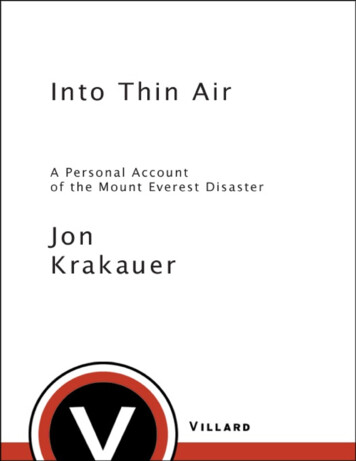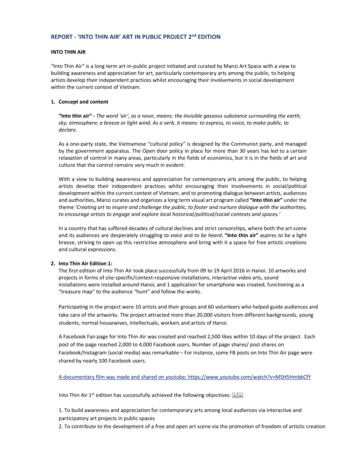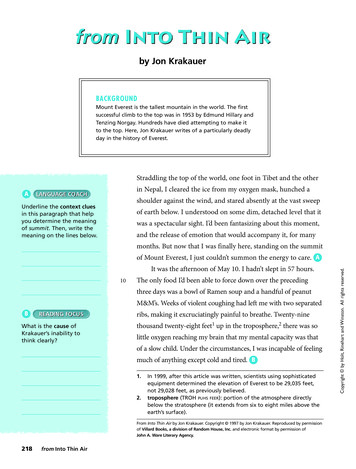
Transcription
Praise for Jon Krakauer’sINTO THIN AIR“A book that offers readers the emotional immediacy of a survivor’s testament as well as the precision, detail, andquest for accuracy of a great piece of journalism. It is impossible to read this book unmoved.”—ENTERTAINMENT WEEKLY“Brilliant, haunting. This is an angry book, made even more so by the fact that hardly anyone seems to have learneda thing from the tragedy.”—SAN FRANCISCO EXAMINER“Every bit as absorbing and unnerving as his bestseller, Into the Wild.”—THE NEW YORK TIMES“A searing book.”—OUTSIDE“Krakauer is an extremely gifted storyteller as well as a relentlessly honest and even-handed journalist, the story isriveting and wonderfully complex in its own right, and Krakauer makes one excellent decision after another about howto tell it. To call the book an adventure saga seems not to recognize that it is also a deeply thoughtful and finelywrought philosophical examination of the self.”—ELLE“Krakauer introduces the many players until they feel familiar, then leads the reader with them up the mountain andinto the so-called ‘Death Zone’ above 25,000 feet.”—SAN FRANCISCO CHRONICLE“Time collapses as, minute-by-minute, Krakauer rivetingly and movingly chronicles what ensued, much of which isnear agony to read. A brilliantly told story.”—KIRKUS REVIEWS“[Krakauer] proves as sure-footed in prose as he was on the mountain quietly building the suspense as we followthe ill-fated expedition through its preparation and shakedown forays, and then delivering a lucid, blow-by-blowaccount of the cataclysmic storm and the death and agony following in its wake.”—THE NEW YORK OBSERVER“Into Thin Air reads like a fine novel—the main characters breathe their way through a plot so commanding, the bookis hard to put down.”—AMAZON REVIEWS“Make room on your shelf for mountaineering classics. Krakauer’s grip on your emotions will leave you gasping forbreath.”
—LOS ANGELES TIMES“[A] riveting account of events leading to the death of guides Rob Hall and Scott Fischer, assistant Andy Harris and twoclients.”—BOSTON HERALD“[A] gripping analysis of the tragedy.”—THE TENNESSEAN“Into Thin Air is the intense, taut, driving account of what happened. It is an engrossing book, difficult for thereader to put down superbly reported.”—ROCKY MOUNTAIN NEWS“Astounding honest eloquent. Through objective and thorough research and in sparkling prose, Krakauer tellsa story that arouses fury, disgust, admiration and tears.”—THE TIMES-PICAYUNE (NEW ORLEANS)“Meticulously researched and exceptionally well-written, Into Thin Air avoids the hype and easy condemnation thathave infested other accounts. The book offers instead vivid details told matter-of-factly, almost quietly. The result is adeeply moving narrative that honors the courage of the people on the mountain while raising profound and possiblyunanswerable questions about human behavior in a crisis.”—NASHVILLE BOOK PAGE“Jon Krakauer offers fresh insights into the tragedy in his superb Into Thin Air, in which he adroitly sifts through themisunderstandings, miscalculations and misguided zeal that led his fellow climbers to their doom. His new book is, onevery level, a worthy successor to his outstanding Into the Wild.”—THE PLAIN DEALER“A taut, harrowing narrative of the most lethal season in Everest’s history Krakauer offers a disturbing look at howtechnology, publicity, and commercialism have changed mountaineering.”—WISCONSIN STATE-JOURNAL“Just as he did in his previous book, the acclaimed Into the Wild, Krakauer employs exhaustive reporting, attention todetail, and a crisp, unpretentious writing style to shape the story.”—HARTFORD COURANT“The intensity of the tragedy is haunting, and Krakauer’s graphic writing drives it home.”—PUBLISHERS WEEKLY“[Krakauer] has produced a narrative that is both meticulously researched and deftly constructed. His story rushesirresistibly forward.”—THE NEW YORK TIMES BOOK REVIEW“Though it comes from the genre named for what it isn’t (nonfiction), this has the feel of literature: Krakauer isIshmael, the narrator who lives to tell the story but is forever trapped within it. Krakauer’s reporting is steady butferocious. The clink of ice in a glass, a poem of winter snow, will never sound the same.”—MIRABELLA
“Every once in a while a work of nonfiction comes along that’s as good as anything a novelist could make up IntoThin Air fits the bill.”—FORBES“Deeply upsetting, genuinely nightmarish. Krakauer writes indelibly. He’s brilliant. His story contains whatmust be one of the essences of hell: the unceasing potential for things to become worse than you fear.”—SALON“Into Thin Air is a remarkable work of reportage and self-examination. And no book on the 1996 disaster is likely toconsider so honestly the mistakes that killed his colleagues.”—NEWSDAY“Jon Krakauer combines the tenacity and courage of the finest tradition of investigative journalism with the stylishsubtlety and profound insight of the born writer. His account of an ascent of Mount Everest has led to a generalreevaluation of climbing and of the commercialization of what was once a romantic, solitary sport, while his accountof the life and death of Christopher McCandless, who died of starvation after challenging the Alaskan wilderness, delveseven more deeply and disturbingly into the fascination of nature and the devastating effects of its lure on a young andcurious mind.”—ACADEMY AWARD IN LITERATURECITIATION FROM THE AMERICANACADEMY OF ARTS AND LETTERS
ALSO BY JON KRAKAUERIcelandEiger DreamsInto the WildUnder the Banner of Heaven
JON KRAKAUERINTO THIN AIRJon Krakauer is the author of Eiger Dreams, Into the Wild, Into Thin Air, Under the Banner of Heaven, and Where MenWin Glory, and is the editor of the Modern Library Exploration series.
Anchor Books Mass-Market Edition, August 2009Copyright 1997 by Jon KrakauerMap copyright 1997 by Anita KarlPostscript copyright 1999 by Jon KrakauerAll rights reserved. Published in the United States by Anchor Books, a division of Random House, Inc., New York, andsimultaneously in Canada by Random House of Canada Limited, Toronto. Originally published in hardcover in the United Statesby Villard Books in 1997. The Anchor Books edition is published by arrangement with Villard Books.Anchor Books and colophon are registered trademarks of Random House, Inc.Portions of this work were originally published in Outside.Library of Congress Cataloguing-in-Publication DataKrakauer, Jon.Into thin air: a personal account of the Mount EverestDisaster/Jon Krakauer.—1st Anchor Books ed.p. cm.Originally published: New York: Villard, c1997.1. Mountaineering accidents—Everest, Mount (China and Nepal).2. Mount Everest Expedition (1996). 3. Krakauer, Jon. I. Title.[GV199.44.E85K725 1998]796.52′2′092—dc2197-42880eISBN: 978-0-679-46271-2www.anchorbooks.comv3.1 r1
For Linda;and in memory of Andy Harris, Doug Hansen,Rob Hall, Yasuko Namba, Scott Fischer, NgawangTopche Sherpa, Chen Yu-Nan, Bruce Herrod,Lopsang Jangbu Sherpa, and Anatoli Boukreev
ContentsCoverOther Books by This AuthorAbout the AuthorTitle rChapterChapterChapterChapterChapterChapterOne - Everest Summit: May 10, 1996 29,028 FeetTwo - Dehra Dun, India: 1852 2,234 FeetThree - Over Northern India: March 29, 1996 30,000 FeetFour - Phakding: March 31, 1996 9,186 FeetFive - Lobuje: April 8, 1996 16,200 FeetSix - Everest Base Camp: April 12, 1996 17,600 FeetSeven - Camp One: April 13, 1996 19,500 FeetEight - Camp One: April 16, 1996 19,500 FeetNine - Camp Two: April 28, 1996 21,300 FeetTen - Lhotse Face: April 29, 1996 23,400 FeetEleven - Base Camp: May 6, 1996 17,600 FeetTwelve - Camp Three: May 9, 1996 24,000 FeetThirteen - Southeast Ridge: May 10, 1996 27,600 FeetFourteen - Summit: 1:12 P.M., May 10, 1996 29,028 FeetFifteen - Summit: 1:25 P.M., May 10, 1996 29,028 FeetSixteen - South Col: 6:00 A.M., May 11, 1996 26,000 FeetSeventeen - Summit: 3:40 P.M., May 10, 1996 29,028 FeetEighteen - Northeast Ridge: May 10, 1996 28,550 FeetNineteen - South Col: 7:30 A.M., May 11, 1996 26,000 FeetTwenty - The Geneva Spür: 9:45 A.M., May 12, 1996 25,900 FeetTwenty-One - Everest Base Camp: May 13, 1996 17,600 FeetEpilogue - Seattle: November 29, 1996 270 FeetAuthor’s NotePostscriptSelected BibliographyAcknowledgments
Men play at tragedy because they do not believe inthe reality of the tragedy which is actually beingstaged in the civilised world.—José Ortega y Gasset
INTRODUCTIONIn March 1996, Outside magazine sent me to Nepal to participate in, and write about, aguided ascent of Mount Everest. I went as one of eight clients on an expedition led by awell-known guide from New Zealand named Rob Hall. On May 10 I arrived on top of themountain, but the summit came at a terrible cost.Among my five teammates who reached the top, four, including Hall, perished in a roguestorm that blew in without warning while we were still high on the peak. By the time I’ddescended to Base Camp nine climbers from four expeditions were dead, and three morelives would be lost before the month was out.The expedition left me badly shaken, and the article was difficult to write. Nevertheless,five weeks after I returned from Nepal I delivered a manuscript to Outside, and it waspublished in the September issue of the magazine. Upon its completion I attempted to putEverest out of my mind and get on with my life, but that turned out to be impossible.Through a fog of messy emotions, I continued trying to make sense of what had happenedup there, and I obsessively mulled the circumstances of my companions’ deaths.The Outside piece was as accurate as I could make it under the circumstances, but mydeadline had been unforgiving, the sequence of events had been frustratingly complex, andthe memories of the survivors had been badly distorted by exhaustion, oxygen depletion,and shock. At one point during my research I asked three other people to recount anincident all four of us had witnessed high on the mountain, and none of us could agree onsuch crucial facts as the time, what had been said, or even who had been present. Withindays after the Outside article went to press, I discovered that a few of the details I’dreported were in error. Most were minor inaccuracies of the sort that inevitably creep intoworks of deadline journalism, but one of my blunders was in no sense minor, and it had adevastating impact on the friends and family of one of the victims.Only slightly less disconcerting than the article’s factual errors was the material thatnecessarily had to be omitted for lack of space. Mark Bryant, the editor of Outside, andLarry Burke, the publisher, had given me an extraordinary amount of room to tell the story:they ran the piece at 17,000 words—four or five times as long as a typical magazinefeature. Even so, I felt that it was much too abbreviated to do justice to the tragedy. TheEverest climb had rocked my life to its core, and it became desperately important for me torecord the events in complete detail, unconstrained by a limited number of column inches.This book is the fruit of that compulsion.The staggering unreliability of the human mind at high altitude made the researchproblematic. To avoid relying excessively on my own perceptions, I interviewed most of theprotagonists at great length and on multiple occasions. When possible I also corroborateddetails with radio logs maintained by people at Base Camp, where clear thought wasn’t insuch short supply. Readers familiar with the Outside article may notice discrepanciesbetween certain details (primarily matters of time) reported in the magazine and thosereported in the book; the revisions reflect new information that has come to light since
publication of the magazine piece.Several authors and editors I respect counseled me not to write the book as quickly as Idid; they urged me to wait two or three years and put some distance between me and theexpedition in order to gain some crucial perspective. Their advice was sounds, but in theend I ignored it—mostly because what happened on the mountain was gnawing my gutsout. I thought that writing the book might purge Everest from my life.It hasn’t, of course. Moreover, I agree that readers are often poorly served when anauthor writes as an act of catharsis, as I have done here. But I hoped something would begained by spilling my soul in the calamity’s immediate aftermath, in the roil and torment ofthe moment. I wanted my account to have a raw, ruthless sort of honesty that seemed indanger of leaching away with the passage of time and the dissipation of anguish.Some of the same people who warned me against writing hastily had also cautioned meagainst going to Everest in the first place. There were many, many fine reasons not to go,but attempting to climb Everest is an intrinsically irrational act—a triumph of desire oversensibility. Any person who would seriously consider it is almost by definition beyond thesway of reasoned argument.The plain truth is that I knew better but went to Everest anyway. And in doing so I was aparty to the death of good people, which is something that is apt to remain on myconscience for a very long time.Jon KrakauerSeattleNovember 1996
DRAMATIS PERSONAEMount Everest Spring 1996*Adventure Consultants Guided ExpeditionRob HallNew Zealand, leader and head guideMike GroomAustralia, guideAndy “Harold” HarrisNew Zealand, guideHelen WiltonNew Zealand, Base Camp managerDr. Caroline MackenzieNew Zealand, Base Camp doctorAng Tshering SherpaNepal, Base Camp sirdarAng Dorje SherpaNepal, climbing sirdarLhakpa Chhiri SherpaNepal, climbing SherpaKami SherpaNepal, climbing SherpaTenzing SherpaNepal, climbing SherpaArita SherpaNepal, climbing SherpaNgawang Norbu SherpaNepal, climbing SherpaChuldum SherpaNepal, climbing SherpaChhongba SherpaNepal, Base Camp cookPemba SherpaNepal, Base Camp SherpaTendi SherpaNepal, cook boyDoug HansenUSA, clientDr. Seaborn Beck WeathersUSA, clientYasuko NambaJapan, clientDr. Stuart HutchisonCanada, clientFrank FischbeckHong Kong, clientLou KasischkeUSA, clientDr. John TaskeAustralia, clientJon KrakauerUSA, client and journalist
Susan AllenAustralia, trekkerNancy HutchisonCanada, trekkerMountain Madness Guided ExpeditionScott FischerUSA, leader and head guideAnatoli BoukreevRussia, guideNeal BeidlemanUSA, guideDr. Ingrid HuntUSA, Base Camp manager, team doctorLopsang Jangbu SherpaNepal, climbing sirdarNgima Kale SherpaNepal, Base Camp sirdarNgawang Topche SherpaNepal, climbing SherpaTashi Tshering SherpaNepal, climbing SherpaNgawang Dorje SherpaNepal, climbing SherpaNgawang Sya Kya SherpaNepal, climbing SherpaNgawang Tendi SherpaNepal, climbing SherpaTendi SherpaNepal, climbing Sherpa“Big” Pemba SherpaNepal, climbing SherpaJeta SherpaNepal, Base Camp SherpaPemba SherpaNepal, Base Camp cook boySandy Hill PittmanUSA, client and journalistCharlotte FoxUSA, clientTim MadsenUSA, clientPete SchoeningUSA, clientKlev SchoeningUSA, clientLene GammelgaardDenmark, clientMartin AdamsUSA, clientDr. Dale KruseUSA, clientJane BrometUSA, journalistMacGillivray Freeman IMAX/IWERKS Expedition
David BreashearsUSA, leader and film directorJamling Norgay SherpaIndia, deputy leader and film talentEd ViestursUSA, climber and film talentAraceli SegarraSpain, climber and film talentSumiyo TsuzukiJapan, climber and film talentRobert SchauerAustria, climber and cinematographerPaula Barton ViestursUSA, Base Camp managerAudrey SalkeldU.K., journalistLiz CohenUSA, film production managerLiesl ClarkUSA, film producer and writerWongchu SherpaNepal, sirdarJangbu SherpaNepal, lead camera SherpaTaiwanese National Expedition“Makalu” Gau Ming-HoTaiwan, leaderChen Yu-NanTaiwan, climberKao Tien TzuTaiwan, climberChang Jung ChangTaiwan, climberHsieh Tzu ShengTaiwan, climberChhiring SherpaNepal, sirdarKami Dorje SherpaNepal, climbing SherpaNgima Gombu SherpaNepal, climbing SherpaMingma Tshering SherpaNepal, climbing SherpaTenzing Nuri SherpaNepal, climbing SherpaDorje SherpaNepal, climbing SherpaPasang TamangNepal, climbing SherpaKi Kami SherpaNepal, climbing SherpaJohannesburg Sunday Times Expedition
Ian WoodallU.K., leaderBruce HerrodU.K., deputy leader and photographerCathy O’DowdSouth Africa, climberDeshun DeyselSouth Africa, climberEdmund FebruarySouth Africa, climberAndy de KlerkSouth Africa, climberAndy HacklandSouth Africa, climberKen WoodallSouth Africa, climberTierry RenardFrance, climberKen OwenSouth Africa, journalist and trekkerPhilip WoodallU.K., Base Camp managerAlexandrine GaudinFrance, administrative assistantDr. Charlotte NobleSouth Africa, team doctorKen VernonAustralia, journalistRichard ShoreySouth Africa, photographerPatrick ConroySouth Africa, radio journalistAng Dorje SherpaNepal, climbing sirdarPemba Tendi SherpaNepal, climbing SherpaJangbu SherpaNepal, climbing SherpaAng Babu SherpaNepal, climbing SherpaDawa SherpaNepal, climbing SherpaAlpine Ascents International Guided ExpeditionTodd BurlesonUSA, leader and guidePete AthansUSA, guideJim WilliamsUSA, guideDr. Ken KamlerUSA, client and team doctorCharles CorfieldUSA, clientBecky JohnstonUSA, trekker and screenwriter
International Commercial ExpeditionMal DuffU.K., leaderMike TruemanHong Kong, deputy leaderMichael BurnsU.K., Base Camp managerDr. Henrik Jessen HansenDenmark, expedition doctorVeikka GustafssonFinland, climberKim SejbergDenmark, climberGinge FullenU.K., climberJaakko KurvinenFinland, climberEuan DuncanU.K., climberHimalayan Guides Commercial ExpeditionHenry ToddU.K., leaderMark PfetzerUSA, climberRay DoorUSA, climberMichael JorgensenDenmark, climberBrigitte MuirAustralia, climberPaul DeeganU.K., climberNeil LaughtonU.K., climberGraham RatcliffeU.K., climberThomas SjögrenSweden, climberTina SjögrenSweden, climberKami Nuru SherpaNepal, sirdarSwedish Solo ExpeditionGöran KroppSweden, climberFrederic BloomquistSweden, filmmakerAng Rita SherpaNepal, climbing Sherpa and film crew memberNorwegian Solo Expedition
Petter NebyNorway, climberNew Zealand-Malaysian Guided Pumori ExpeditionGuy CotterNew Zealand, leader and guideDave HiddlestonNew Zealand, guideChris JilletNew Zealand, guideAmerican Commercial Pumori/Lhotse ExpeditionDan MazurUSA, leaderScott DarsneyUSA, climber and photographerChantal MauduitFrance, climberStephen KochUSA, climber and snowboarderBrent BishopUSA, climberJonathan PrattU.K., climberDiane TaliaferroUSA, climberDave SharmanU.K., climberTim HorvathUSA, climberDana LyngeUSA, climberMartha JohnsonUSA, climberNepali Everest Cleaning ExpeditionSonam Gyalchhen SherpaNepal, leaderHimalayan Rescue Association Clinic(in Pheriche Village)Dr. Jim LitchUSA, staff doctorDr. Larry SilverUSA, staff doctorDr. Cecile BouvrayFrance, staff doctorLaura ZiemerUSA, assistantIndo-Tibetan Border Police Everest Expedition
(climbing from the Tibetan side of the mountain)Mohindor SinghIndia, leaderHarbhajan SinghIndia, deputy leader and climberTsewang SmanlaIndia, climberTsewang PaljorIndia, climberDorje MorupIndia, climberHira RamIndia, climberTashi RamIndia, climberSange SherpaIndia, climbing SherpaNadra SherpaIndia, climbing SherpaKoshing SherpaIndia, climbing SherpaJapanese-Fukuoka Everest Expedition(climbing from the Tibetan side of the mountain)Koji YadaJapan, leaderHiroshi HanadaJapan, climberEisuke ShigekawaJapan, climberPasang Tshering SherpaNepal, climbing SherpaPasang Kami SherpaNepal, climbing SherpaAny GyalzenNepal, climbing Sherpa* Not everyone present on Mt. Everest in the spring of 1996 is listed.
ONEEVEREST SUMMITMAY 10, 1996 29,028 FEETIt would seem almost as though there were a cordon drawn round the upper part of these great peaks beyond which no manmay go. The truth of course lies in the fact that, at altitudes of 25,000 feet and beyond, the effects of low atmosphericpressure upon the human body are so severe that really difficult mountaineering is impossible and the consequences even of amild storm may be deadly, that nothing but the most perfect conditions of weather and snow offers the slightest chance ofsuccess, and that on the last lap of the climb no party is in a position to choose its day. No, it is not remarkable that Everest did not yield to the first few attempts; indeed, it would have been very surprising andnot a little sad if it had, for that is not the way of great mountains. Perhaps we had become a little arrogant with our fine newtechnique of ice-claw and rubber slipper, our age of easy mechanical conquest. We had forgotten that the mountain still holdsthe master card, that it will grant success only in its own good time. Why else does mountaineering retain its deep fascination?Eric Shipton, in 1938SUpon That Mountaintraddling the top of the world, one foot in China and the other in Nepal, Icleared the ice from my oxygen mask, hunched a shoulder against the wind, andstared absently down at the vastness of Tibet. I understood on some dim, detached levelthat the sweep of earth beneath my feet was a spectacular sight. I’d been fantasizing aboutthis moment, and the release of emotion that would accompany it, for many months. Butnow that I was finally here, actually standing on the summit of Mount Everest, I justcouldn’t summon the energy to care.It was early in the afternoon of May 10, 1996. I hadn’t slept in fifty-seven hours. The onlyfood I’d been able to force down over the preceding three days was a bowl of ramen soupand a handful of peanut M&Ms. Weeks of violent coughing had left me with two separatedribs that made ordinary breathing an excruciating trial. At 29,028 feet up in thetroposphere, so little oxygen was reaching my brain that my mental capacity was that of aslow child. Under the circumstances, I was incapable of feeling much of anything exceptcold and tired.I’d arrived on the summit a few minutes after Anatoli Boukreev, a Russian climbing guideworking for an American commercial expedition, and just ahead of Andy Harris, a guide onthe New Zealand–based team to which I belonged. Although I was only slightly acquaintedwith Boukreev, I’d come to know and like Harris well during the preceding six weeks. Isnapped four quick photos of Harris and Boukreev striking summit poses, then turned andheaded down. My watch read 1:17 P.M. All told, I’d spent less than five minutes on the roofof the world.A moment later, I paused to take another photo, this one looking down the SoutheastRidge, the route we had ascended. Training my lens on a pair of climbers approaching thesummit, I noticed something that until that moment had escaped my attention. To the south,where the sky had been perfectly clear just an hour earlier, a blanket of clouds now hid
Pumori, Ama Dablam, and the other lesser peaks surrounding Everest.Later—after six bodies had been located, after a search for two others had beenabandoned, after surgeons had amputated the gangrenous right hand of my teammate BeckWeathers—people would ask why, if the weather had begun to deteriorate, had climbers onthe upper mountain not heeded the signs? Why did veteran Himalayan guides keep movingupward, ushering a gaggle of relatively inexperienced amateurs—each of whom had paid asmuch as 65,000 to be taken safely up Everest—into an apparent death trap?Nobody can speak for the leaders of the two guided groups involved, because both menare dead. But I can attest that nothing I saw early on the afternoon of May 10 suggestedthat a murderous storm was bearing down. To my oxygen-depleted mind, the clouds driftingup the grand valley of ice known as the Western Cwm* looked innocuous, wispy,insubstantial. Gleaming in the brilliant midday sun, they appeared no different from theharmless puffs of convection condensation that rose from the valley almost every afternoon.As I began my descent I was extremely anxious, but my concern had little to do with theweather: a check of the gauge on my oxygen tank had revealed that it was almost empty. Ineeded to get down, fast.The uppermost shank of Everest’s Southeast Ridge is a slender, heavily corniced fin ofrock and wind-scoured snow that snakes for a quarter mile between the summit and asubordinate pinnacle known as the South Summit. Negotiating the serrated ridge presentsno great technical hurdles, but the route is dreadfully exposed. After leaving the summit,fifteen minutes of cautious shuffling over a 7,000-foot abyss brought me to the notoriousHillary Step, a pronounced notch in the ridge that demands some technical maneuvering. AsI clipped into a fixed rope and prepared to rappel over the lip, I was greeted with analarming sight.Thirty feet below, more than a dozen people were queued up at the base of the Step.Three climbers were already in the process of hauling themselves up the rope that I waspreparing to descend. Exercising my only option, I unclipped from the communal safetyline and stepped aside.The traffic jam was comprised of climbers from three expeditions: the team I belonged to,a group of paying clients under the leadership of the celebrated New Zealand guide RobHall; another guided party headed by the American Scott Fischer; and a noncommercialTaiwanese team. Moving at the snail’s pace that is the norm above 26,000 feet, the thronglabored up the Hillary Step one by one, while I nervously bided my time.Harris, who’d left the summit shortly after I did, soon pulled up behind me. Wanting toconserve whatever oxygen remained in my tank, I asked him to reach inside my backpackand turn off the valve on my regulator, which he did. For the next ten minutes I feltsurprisingly good. My head cleared. I actually seemed less tired than I had with the gasturned on. Then, abruptly, I sensed that I was suffocating. My vision dimmed and my headbegan to spin. I was on the brink of losing consciousness.Instead of turning my oxygen off, Harris, in his hypoxically impaired state, hadmistakenly cranked the valve open to full flow, draining the tank. I’d just squandered thelast of my gas going nowhere. There was another tank waiting for me at the South Summit,
250 feet below, but to get there I would have to descend the most exposed terrain on theentire route without the benefit of supplemental oxygen.And first I had to wait for the mob to disperse. I removed my now useless mask, plantedmy ice ax into the mountain’s frozen hide, and hunkered on the ridge. As I exchanged banalcongratulations with the climbers filing past, inwardly I was frantic: “Hurry it up, hurry itup!” I silently pleaded. “While you guys are fucking around here, I’m losing brain cells bythe millions!”Most of the passing crowd belonged to Fischer’s group, but near the back of the paradetwo of my teammates eventually appeared, Rob Hall and Yasuko Namba. Demure andreserved, the forty-seven-year-old Namba was forty minutes away from becoming the oldestwoman to climb Everest and the second Japanese woman to reach the highest point on eachcontinent, the so-called Seven Summits. Although she weighed just ninety-one pounds, hersparrowlike proportions disguised a formidable resolve; to an astounding degree, Yasukohad been propelled up the mountain by the unwavering intensity of her desire.Later still, Doug Hansen arrived atop the Step. Another member of our expedition, Dougwas a postal worker from a Seattle suburb who’d become my closest friend on themountain. “It’s in the bag!” I yelled over the wind, trying to sound more upbeat than I felt.Exhausted, Doug mumbled something from behind his oxygen mask that I didn’t catch,shook my hand weakly, then continued plodding upward.At the very end of the line was Scott Fischer, whom I knew casually from Seattle, wherewe both lived. Fischer’s strength and drive were legendary—in 1994 he’d climbed Everestwithout using bottled oxygen—so I was surprised at how slowly he was moving and howhammered he looked when he pulled his mask aside to say hello. “Bruuuuuuce!” he wheezedwith forced cheer, employing his trademark frat-boyish greeting. When I asked how he wasdoing, Fischer insisted that he was feeling fine: “Just dragging ass a little today for somereason. No big deal.” With the Hillary Step finally clear, I clipped into the strand of orangerope, swung quickly around Fischer as he slumped over his ice ax, and rappelled over theedge.It was after three o’clock when I made it down to the South Summit. By now tendrils ofmist were streaming over the 27,923-foot top of Lhotse and lapping at Everest’s summitpyramid. No longer did the weather look so benign. I grabbed a fresh oxygen cylinder,jammed it onto my regulator, and hurried down into the gathering cloud. Moments after Idropped below the South Summit, it began to snow lightly and visibility went to hell.Four hundred vertical feet above, where the summit was still washed in bright sunlightunder an immaculate cobalt sky, my compadres dallied to memorialize their arrival at theapex of the planet, unfurling flags and snapping photos, using up precious ticks of theclock. None of them imagined that a horrible ordeal was drawing nigh. Nobody suspectedthat by the end of that long day, every minute would matter.* The Western Cwm, pronounced koom, was named by George Leigh Mallory, who first saw it during the initial Everestexpedition of 1921 from the Lho La, a high pass on the border between Nepal and Tibet. Cwm is a Welsh term for valley orcirque.
TWODEHRA DUN, INDIA1852 2,234 FEETFar from the mountains in winter, I discovered the blurred photo of Everest in Richard Halliburton’s Book of Marvels. It was amiserable reproduction in which the jagged peaks rose white against a grotesquely blackened and scratched sky. Everest itself,sitting back from the front ones, didn’t even appear highest, but it didn’t matter. It was; the legend said so. Dreams were thekey to the picture, permitting a boy to enter it, to stand at
Into Thin Air fits the bill." —FORBES "Deeply upsetting, genuinely nightmarish. Krakauer writes indelibly. He's brilliant. His story contains what must be one of the essences of hell: the unceasing potential for things to become worse than you fear." —SALON "Into Thin Air is a remarkable work of reportage and self .










